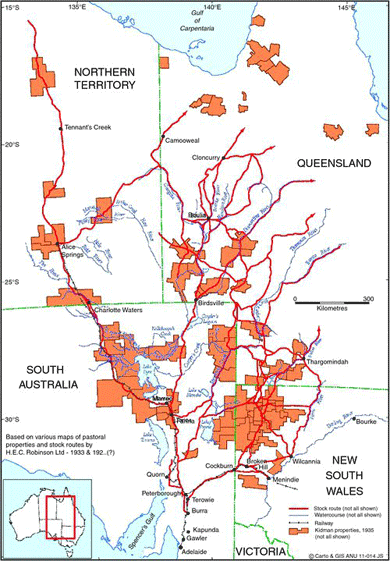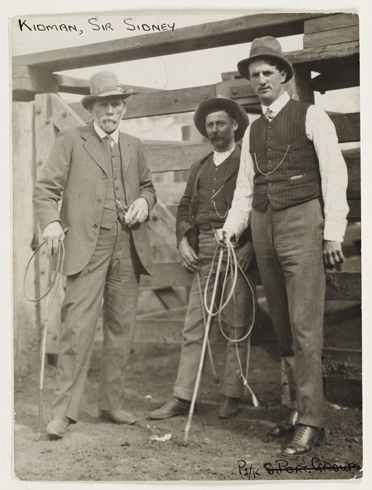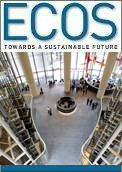
|
Published: 20 March 2012
Cattle king a climate adaptation pioneer?
Australian cattle king Sir Sidney Kidman (1857–1935) thrived in Australia’s ‘dead heart’, a huge arid area that few regarded as good pastoral land. His unorthodox approach to dealing with this unpredictable climate and landscape may contain valuable lessons for today’s graziers when adapting their enterprises to climate change.
Sir Kidman was a maverick, an adopter of practices that were innovative and unorthodox for their time. His achievements are all the more remarkable because he established his property empire in the face of old and new adversities. The highly variable, unpredictable rainfall characteristic of central Australia was one of the age-old challenges Kidman overcame. At the same time, he had to contend with a series of ‘exogenous shocks’ such as rabbits, overstocking, the spread of cattle tick, and periodic drought.
Although Kidman periodically bought and sold properties, he owned or held a commercial interest in a large chunk of Australia throughout much of his life. Even today, the Kidman Company is one of Australia’s largest landholders.
Kidman’s land holdings created two major chains of properties that allowed him to move cattle from the north to markets in the south. The properties tended to straddle stock routes and watercourses, or be close to them; additionally, the southern boundaries of both were on, or close to, railways in South Australia.
Kidman’s stock were:
-
bred on properties in the Northern Territory and northern Queensland, where climate (tropical with short rainy season) and native vegetation (i.e. summer-active, C4-photosynthetic-pathway grasses such as Mitchell grass 1 ) improved breeding success.
-
often purchased ‘on the hoof’ from drovers or other properties through which his stock were being moved
-
finished on more southern properties, such as those in the Channel country of south-west Queensland, where temperate native grasses and herbage provided more nutritious feed over the longer term.
-
moved to market along generally contiguous properties running west of the Darling River Broken Hill or Marree; and along the stock route to the west of Lake Eyre via Charlotte Waters to Farina.
In central Australia, rainfall is highly irregular in volume, and unpredictable from season to season, and year to year. It is not uncommon to have no rainfall all for several years. The availability of water and feed for cattle is thus not only highly variable, but also highly uncertain.
Because of this, Kidman did not fully stock his properties – a radical move at the time. This provided him with the flexibility of moving cattle from drought-affected runs to those where feed was still available. In effect, Kidman managed a system of peripatetic agistment on his own land, avoiding the uncertainty of rainfall and the pitfalls of overgrazing.

|
|
Properties Kidman owned, controlled or in which he had an interest, 1935
Credit:
Leo Dobes
|
Kidman was repeatedly attacked by South Australian politicians for not fully stocking his properties (a practice that aided the regrowth of native vegetation). It was considered at the time that others could have made more productive use of pastoral land leased from the government by fully stocking their runs. He was also blamed for meat shortages in Adelaide.
R. M. Williams – founder of the eponymous bush clothing chain but formerly a stockman and manufacturer of saddlery for the Kidman empire – is reported to have said:
‘I think Kidman was probably the man who handled the Australian bush better than anyone else. He was nomadic. For instance, if there was drought on Glengyle he’d shift cattle to Durrie. If there was no feed at Durrie he’d move down to Innamincka, and further on, and he’d finish up at Broken Hill. And if the country there was bare, the cattle would go on to Adelaide or a market somewhere else. Kidman’s drovers were shifting, shifting, shifting all the time. There was no such thing as starving or dying stock on Kidman’s stations. He just shifted them.’
During Kidman’s lifetime, regions where he held properties suffered a series of major droughts. In addition, by the end of the nineteenth century, cattle ticks had spread across the north of Australia and down into New South Wales.
Many of the stations west of the Darling and in central Australia had been severely overgrazed during droughts, so little usable feed remained, and the spread of rabbits only added to the problem.
The resulting erosion led to the formation of large, drifting sandhills that smothered fences and homesteads. In her book, No Roads Go By, Myrtle White, wife of the manager of Kidman’s Wonnaminta station, graphically described the sand ‘insidiously creeping up the six-foot iron fence, which was our frail barrier against all that moving country’.
Kidman and his station managers were canny information managers, drawing on both European settler and indigenous knowledge. They used an extensive network of drovers, camel drivers, Aborigines, dingo-trappers and telegraph operators to advise on feed availability and condition, as well as rainfall. This helped them move stock to areas offering the best grazing opportunities.
This knowledge network also tracked competing mobs on the way to market. If it became clear that a competitor’s cattle were about to come onto a particular market and depress prices, Kidman switched delivery of his own cattle to an alternative market, where prices were likely to be higher.
The Kidman story provides a cautionary reminder that modern-day proposals for adaptation to climatic variability, or even long-term climate change, should avoid single-strategy risk reduction.
For example, it may be that graziers should consider not only the viability of geographically separated properties (or ‘within property’ variation of vegetation, or both of these), but also the use of agistment.
Uncertainty is the hallmark of climate change, particularly its timing, intensity, local effects, and probability and frequency of extreme events. Deterministic responses are likely to be inappropriate and wasteful of scarce social resources. Kidman is an example of human adaptation that goes beyond a purely deterministic, technical response. His contribution lies in his use of creativity and local knowledge in developing a flexible strategy for coping with systemic uncertainty.
More information
An earlier version of this story was published as a paper in vol. 34, no. 1 of The Rangeland Journal.
1 Perennial grasses can be classified as either C3 or C4 plants. These terms refer to the different pathways that plants use to capture carbon dioxide during photosynthesis. All species have the more primitive C3 pathway, but the additional C4 pathway evolved in species in the wet and dry tropics. The different pathways are important because they are associated with different growth requirements and tolerances. In comparison to C3 plants, C4 plants are more adapted to warm or hot seasonal conditions under moist or dry environments, tend to generate more bulk than C3 grasses (but of lower feed quality), and are less tolerant to frost.




